The HTC One X for AT&T Review
by Brian Klug on May 1, 2012 6:00 PM EST- Posted in
- Smartphones
- Snapdragon
- HTC
- Qualcomm
- MSM8960
- Krait
- Mobile
- Tegra 3
- HTC One
- NVIDIA
This is our the first smartphone we’ve seen with a 28nm SoC, and thus battery life is the big question. Further, the handset includes all the onboard MSM8960 radio goodness as we’ll mention in a bit. The problem with some HTC phones for the longest time was that they shipped with smaller than average batteries - while the competition continued up past 6 Whr, HTC would ship phones with 5 or so. That changes with the HTC One X, which includes a 6.66 Whr (1800 mAh, 3.7V) internal battery. I’m presenting the same battery capacity chart that we did in the Xolo X900 review for a frame of reference.
Like we did with the X900 review, we’re going to present the normalized battery performance - battery life divided by battery capacity - to give a better idea for how this compares with the competition.

As a reminder, the browsing tests happen at 200 nits and consist of a few dozen pages loaded endlessly over WCDMA or WiFi (depending on the test) until the phone powers off. The WiFi hotspot tethering test consists of a single attached client streaming 128 kbps MP3 audio and loading four tabs of the page loading test through the handset over WCDMA with the display off.
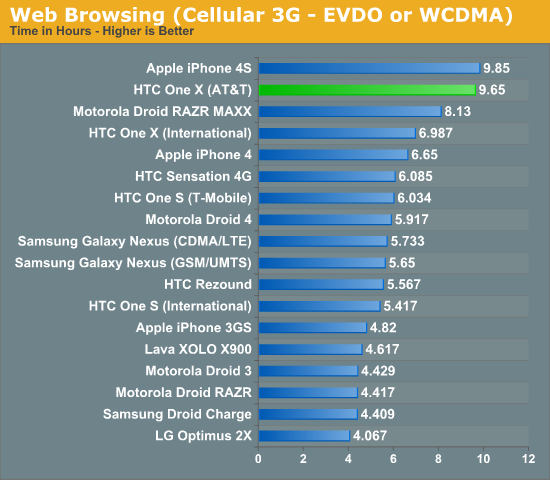
HTC is off to an incredible start with our 3G web browsing tests. Even if you assume that Android and iOS are on even footing from a power efficiency standpoint, the HTC One X is easily able to equal Apple's best in terms of battery life. In reality my guess is that the 4S is at a bit of an unfair advantage in this test due to how aggressive iOS/mobile Safari can be about reducing power consumption, but either way the AT&T One X does amazing here. The advantage isn't just because of the larger battery either, if we look at normalized results we see that the One X is simply a more efficient platform than any other Android smartphone we've tested:
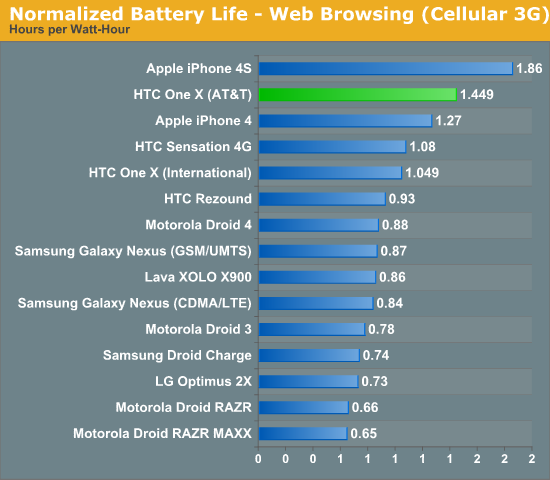
The Tegra 3 based international One X doesn't do as well. NVIDIA tells us that this is because of differences in software. We'll be testing a newer build of the One X's software to see how much of an improvement there is in the coming days.
Moving onto WiFi battery life the AT&T One X continues to do quite well, although the Droid 4 and RAZR MAXX are both able to deliver longer battery life in this case:

There are too many variables at play here (panel efficiency, WiFi stack, browser/software stack) to pinpoint why the One X loses its first place position, but it's still an extremely strong performer. Once again we see a noticeable difference between it and the international One X.
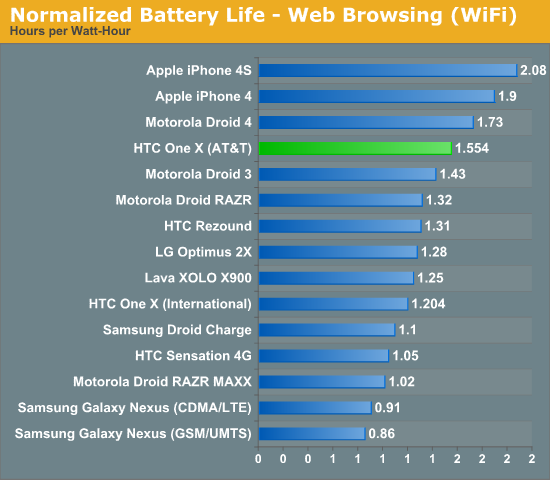
The big question is how well does the AT&T One X do when we're using the MSM8960's LTE baseband? Pretty darn well, when you consider that it's bested only by the RAZR MAXX with its gargantuan battery. Probably the most notable comparison point here is the HTC Vivid or Galaxy Note on AT&T which both are based on the APQ8060 + MDM9200 combination.
As a reminder, the Verizon / CDMA2000 LTE devices here are at a bit of a disadvantage due to virtually all of those handsets camping CDMA2000 1x for voice and SMS. The AT&T LTE enabled devices use circuit switched fallback (CSFB) and essentially only camp one air interface at a time, falling back from LTE to WCDMA to exchange a call.
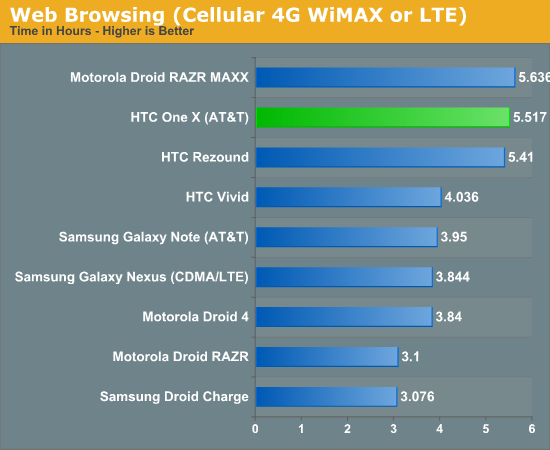
This particular graph doesn't tell the full story however. In practice the AT&T One X seems to last a lot longer using LTE than any LTE Android phone we've tested in the past. Nipping at the heels of the RAZR MAXX, we need to look at normalized battery life to get an idea of just how efficient the new 28nm LTE enabled SoC is:
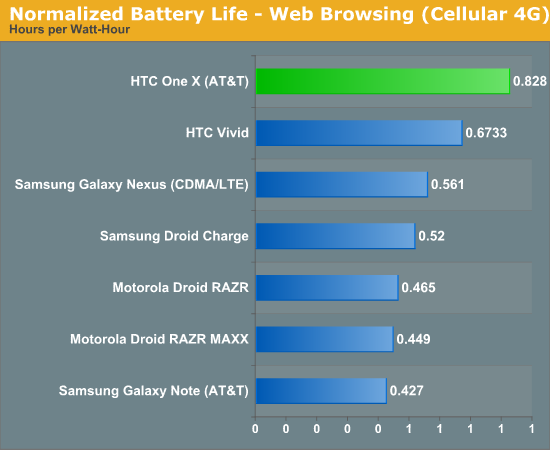
Now that we have 28nm baseband we've immediately realized some power gains. As time progresses, the rest of the RF chain will also get better. Already most of the LTE power amplifiers vendors have newer generation parts with higher PAE (Power-Added Efficiency), and such improvements will hopefully continue to improve things and gradually bring LTE battery life closer to that of 3G WCDMA or EVDO.
Using the AT&T One X as a WiFi hotspot is also going deliver a pretty great experience:
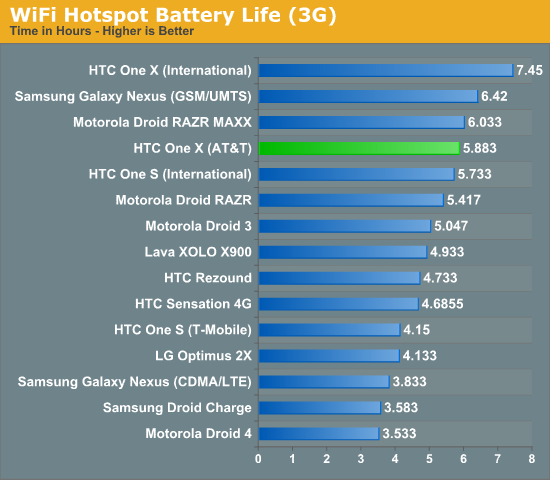
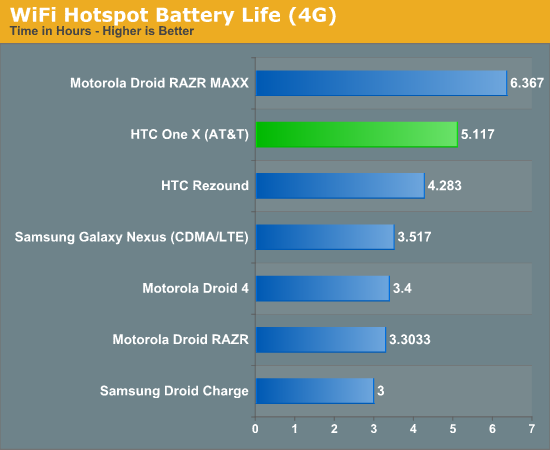
As an LTE hotspot the RAZR MAXX's larger battery is able to deliver a longer run time, however the One X does very well given its battery capacity and size.
Finally, our cellular talk time charts put the AT&T One X in the upper half of our results. Overall the AT&T One X appears to do very well across the board, but it's very strong in the 3G/LTE tests.
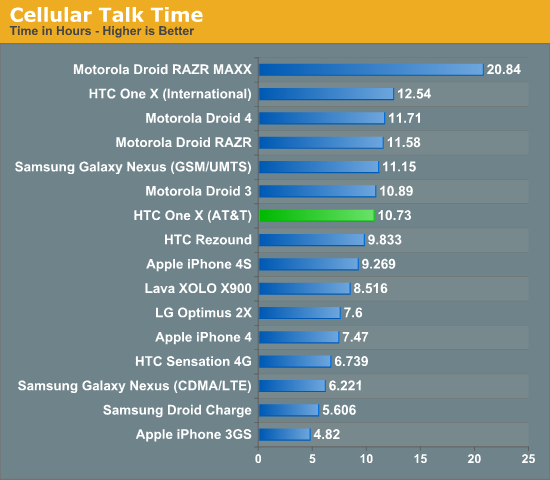
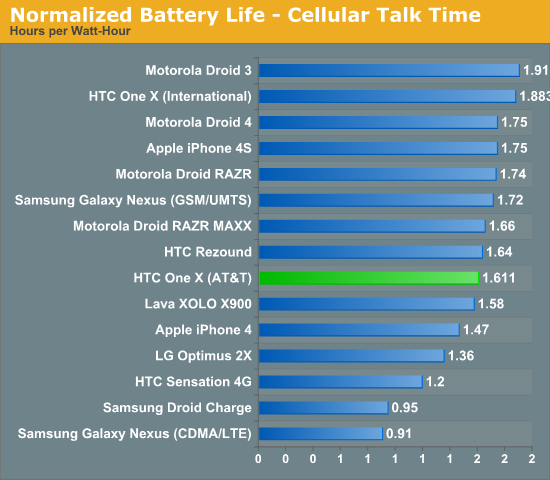










137 Comments
View All Comments
mbzastava - Wednesday, May 2, 2012 - link
oh and i forgot data caps. enjoy running into those more often with LTE and having everything in the cloud.wdb1966 - Friday, May 4, 2012 - link
Exactly!!!On a device specifically targeted to multimedia users, its crazy to NOT have a microSD slot for expansion.
I hope an engineer somewhere lost their job.
I would not use this phone even if it were given to me for FREE!
RussianSensation - Tuesday, May 1, 2012 - link
Samsung S3 is going to launch this week. It's premature to recommend a next generation smartphone without testing the S3, at the very least.dagamer34 - Tuesday, May 1, 2012 - link
I'll bet you good money that the US version of the Galaxy S III is basically an HTC One XL with a microSD card slot, Super AMOLED+ HD screen, and and 12 MP camera.lowlymarine - Tuesday, May 1, 2012 - link
Hasn't it more or less been confirmed that the GS3 is going to be using a quad-core A9 of Samsung's own design? Or did you not mean to imply it would use the same Snapdragon S4 SoC?jwcalla - Wednesday, May 2, 2012 - link
I think I read somewhere that the international version would be the quad-core Samsung A9, but the US version will be a Snapdragon S4. Something about LTE network compatibility.RussianSensation - Wednesday, May 2, 2012 - link
Well at the very least considering it's launching this week, wouldn't you wait for a test against the S3?For starters, the quality of construction already looks better than the HTC One and the screen will be larger.
http://www.gsmarena.com/samsung_galaxy_s_3_should_...
Also, if you happen to listen to music on nice headphones the HTC One also falls short:
http://www.gsmarena.com/htc_one_x-review-747p5.php
All these things already would alone make me want to wait to see how competing new generation Android phones would do.
Impulses - Wednesday, May 2, 2012 - link
You do realize that review is for the Tegra 3 version no? The audio stack and hardware could be completely different on it, the AT&T One X probably shares more in common with the One S since they both run S4...RussianSensation - Thursday, May 3, 2012 - link
Ya, I know that. There are other issues with HTC One, lack of Micro SD card, smaller screen than S3, worse quality construction most likelyl. Also, the video camera and still camera are not great either, and early benchmarks are showing that the Mali-400 and Exynos 4 Quad chip in S3 will easily beat the HTC One X:http://www.gsmarena.com/samsung_galaxy_s_iii_pops_...
Chloiber - Wednesday, May 2, 2012 - link
It won't launch this week. It will be presented this week. Small difference.